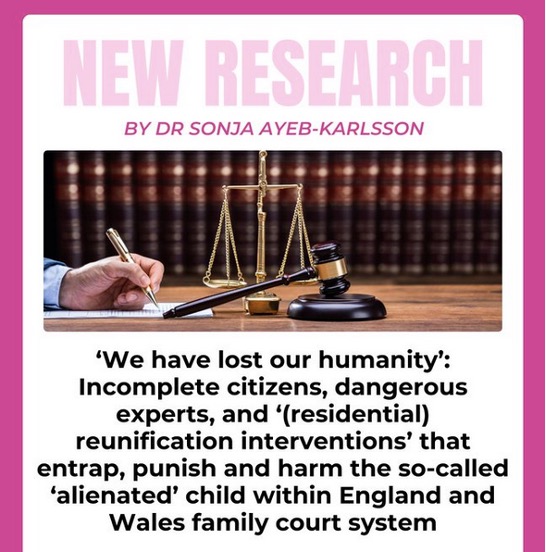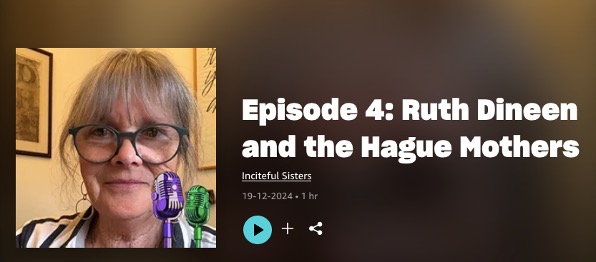Being ‘Hagued’: How Weaponising the Hague Convention Harms Women
This paper looks at the experiences of women who have been ‘Hagued’: forced, through a court-facilitated process enabled by the Hague Abduction Convention, to return children taken unlawfully across international borders. It particularly considers how the Convention, which lacks specific mechanisms to account for family and domestic violence, is weaponised against women fleeing such violence. The authors also suggest improvements that could be made to the Hague: we will be following up these ideas through the Hague Mothers’ project.
One of the authors, Gina Masterton (QUT Centre for Justice) is working with us on the Hague Mother’s project. We are grateful for her permission to republish a version of this paper, co-authored with Zoe Rathus (Griffith University Law School), John Flood (Griffith University School of Humanities, Languages and Social Science) and Kieran Tranter (QUT School of Law).
Background
The Hague Convention on the Civil Aspects of International Child Abduction provides legal machinery to require the rapid return of children who are wrongfully taken from their country of habitual residence. Its original drafters intended it to address the situation where a non-custodial father took their child across international borders without permission from the child’s mother. However, it did not consider the circumstance where a custodial mother must cross international borders with her child to flee family and domestic violence, or that under the Convention she would be termed an abductor. Because the Hague Convention is a jurisdictional law—not a child custody or child welfare law—the return of a child to their habitual residence is primarily ordered so that the courts in that jurisdiction can settle the custody dispute. However, family and domestic violence perpetrators have weaponised the Convention against women trying to escape.
What is known
There has been woefully little research into the experiences of women survivors of family and domestic violence who have been Hagued. One notable exception was a 2010 study commissioned by the United States Department of Justice1 which interviewed twenty-two such women, their lawyers and central authority lawyers. It found that United States courts usually granted Hague applications, ordering children’s return with minimal regard to evidence of family and domestic violence. It also found that in most cases, women and children faced great hardships upon their return, including new abuse by ex-partners. Being Hagued invariably puts the mother back in the father’s country—frequently without familial, social, financial or legal support—providing a perfect context for continued violence.
Today, there is still very little information about survivors’ experiences. In 2021 Merle Weiner commented:
There is no comprehensive data detailing the outcomes in cases involving domestic violence after children are returned. Nor do judges who return children despite a history of domestic violence receive feedback about what actually happens after the children depart. The lack of feedback perpetuates the myth for those adjudicating Hague Convention cases that return will not cause anyone harm. The reality, however, is that things frequently end poorly for the domestic violence survivor and the child after the child is returned. Media outlets, including the internet, produce a sample of anecdotal (and admittedly unconfirmed) hardship stories. Sometimes the mother and/or child are killed. 2
This paper seeks to at least partially address the gap in Australian research by focusing on ten women whose children were returned to Australia and other countries. Six of the women had their children returned to Australia, one had her child returned to New Zealand, one to the USA, one to South America, and one to the U.K. A total of 13 children were returned by Hague courts. Nine mothers chose to return with their children upon receiving the Hague order. One mother was forced to remain behind because she was terrified her ex-partner would try to kill her if she returned to New Zealand with her child. All of those who returned eventually secured access to their children, either by court order or informal agreement, and six of the mothers did so in their chosen country of residence. Despite the enormous challenges they faced, none of the women returned to their abusive ex-partners.
The authors are deeply grateful to the women who participated in the study for sharing and discussing their private and personal experiences of post-Hague abuse. Their stories reveal the true impact of being Hagued for mothers and their children in circumstances where the Convention is used by abusive fathers to perpetuate abuse.
The weaponisation of the Hague Convention: key findings
- Intimidation and controlling behavior
In complying with Hague orders to return to their ex-partners’ countries, the women became extremely vulnerable and exposed. Their accounts demonstrate two forms of ‘paper abuse’, that is, abuse through legal means such as vexatious lawsuits and court orders. First, the ex-partner would use the Hague processes and other legal levers to force the child, and therefore the woman, to return to his territory. Then, emboldened by his Hague Convention ‘win’, he would exploit family law orders and child support systems to further intimidate, harass and isolate the woman. In Australia, shared parenting orders requires parents to ‘consult’ with one another about major decisions and make a ‘genuine effort’ to reach a ‘joint’ agreement (Family Law Act, 1975). This rule forces family and domestic violence survivors to interact with abusive ex-partners. The abuse suffered would often be exacerbated by local authorities not taking action against the abuser.
- Adverse custody arrangements
The interviewees also experienced traumatic separations from their children post-Hague. They perceived court-imposed reductions to their parenting rights and contact times as punishments for fleeing with their children. Some of them commented that they felt family courts prioritised abusive parents’ contact rights over the children’s safety. The label ‘abductor’ used in the Convention itself exacerbated this situation.
- Homelessness
Returning to the country they had fled from put these women in a vulnerable accommodation situation. This might be expected for women who cannot access social services because they lack citizenship or residency rights. However, homelessness occurred even for women possessing these rights. This was due to lack of income, and often an inability to work due to caring responsibilities, made worse by bureaucratic processes and wait times encountered when trying to get help with accommodation.
Ending the injustices: our recommendations
There is no doubt that the current Hague Convention and its implementation can be hostile to women, family and domestic violence survivors. However, there are ways in which the international machinery for addressing child abduction could be made less indifferent to family and domestic violence and less susceptible to paper abuse.
Three reform options are clearly available. The first is modifying the Convention. The second is changing the domestic laws that facilitate the Convention in its contracting states. The third is facilitating more nuanced, sensitive judicial interpretations of the Convention.
- Amend the convention
An appropriate reform would be to amend the Convention document to better protect abused women and their children. This would include inserting stronger defences against return where there is a context of family and domestic violence, and incorporating an understanding that a child’s return order may compel an abuse survivor to return to violence and harm. However, amending an international convention is a time consuming and difficult task.
- Amend the domestic Hague regulations
For women Hagued in Australia, a simpler, more achievable reform would be to amend Regulation 16(1)(b) of the Family Law (Child Abduction Conventions) 1986 which states that a return order does not have to be made if to do so would cause the child to suffer from grave psychological or physical harm, or would place them in an intolerable situation. We recommend that the connection between ‘grave risk of harm’ and family and domestic violence is made explicit, and that such violence is deemed an ‘intolerable situation’. This proposal is not new. It was first suggested in 1994 (Australian Law Reform Commission, 1994, Recommendation 9.5). However, it has not been enacted.
- Alter central authorities’ and courts’ approaches
An alternative reform approach would involve requiring Hague judges to consider more thoroughly what post-Hague life will be like for women, by investigating the context from which a woman fled and the circumstances she is likely to face on return. They would need to address their often unfounded assumption that jurisdictions to which children are returned adequately protect against domestic violence. The data shows this to be untrue. One woman is killed every nine days in Australia by domestic homicide alone. The World Health Organization has declared that ‘violence against women—particularly intimate partner violence and sexual violence—is a major public health problem and a violation of women’s human rights’ (World Health Organization, 2021). Given the apparent inability of relevant authorities, social services and courts to prevent or address such crimes, the attendant risks to the mother need to be considered when granting Hague return orders for their children.
A related change would be to require courts with Hague jurisdiction to consider family and domestic violence when interpreting and applying the Convention. A recent New Zealand Court of Appeal decision represented a significant breakthrough in this area. In ‘the case of Jane’, the New Zealand court held that both the mother’s history as a family and domestic violence survivor and her potential post-Hague future were pertinent to interpreting the grave risk exception. It subsequently declined to order the child’s return (RR v COL, 2020). Significantly, the judges asked wide-ranging questions about the mother’s access to support if she returned to Australia and how that would affect her child. They also probed the central authority about the ex-partner’s criminal history, outstanding charges and previous family court orders.
It is long past time for the Hague Convention and its implementation to be reconsidered and revised.
This injustice cannot be allowed to stand.
References
1. Edleson, J.L., Lindhorst, T., Mehrotra, G., Vesneski, W., Lopez, L. & Shetty, S. (2010). Multiple perspectives on battered mothers and their children fleeing to the United States for safety: A study of Hague Convention cases (NCJ No. 232624). US Department of Justice, Office of Justice Programs. https://www.ojp.gov/ncjrs/virtual-library/abstracts/multiple-perspectives-battered-mothers-and-their-children-fleeing Family Law Act 1975 (Cth),
2. Weiner, M. H. (2021). You can and you should: How judges can apply the Hague Abduction Convention to protect victims of domestic violence. UCLA Journal of Gender and Law, 28(1), 223–332. https://doi.org/10.5070/L328155744




